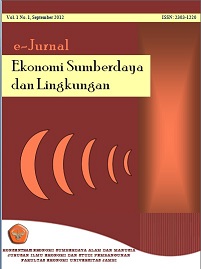Valuasi ekonomi wisata alam Taman Nasional Kerinci Seblat (TNKS) di Kabupaten Kerinci, Provinsi Jambi : menggunakan Contingent Valuation Method
DOI:
https://doi.org/10.22437/jels.v9i2.11952Abstract
This research was conducted on the attraction of Kerinci Seblat National Park located in Pelompek Village, Kerinci Regency, Jambi Province. This study aims to find out how visitors assess the Kerinci Seblat National Park and where visitors come. This study also aims to determine the economic value of the Kerinci Seblat National Park using the Contingent Valuation method in Kerinci Regency, Jambi Province. The total population used as a sample in this study was 99 people. The method used in this research is accidental sampling method. The analytical method used in this study is a descriptive method using the Contingency Valuation Method. From the results of this study was concluded that visitors to the general assessment of the Kerinci Seblat National Park, Kerinci Regency, Jambi Province were quite good. It can be seen from the highest visitor response of 62.92%. Originally tourists come from within the country and from abroad. The economic value of the Kerinci Seblat National Park using the Contingency Valuation Method approach in the Kerinci Regency, based on an analysis of tourist responses to the existence of natural tourism in the Kerinci Seblat National Park. The WTP willingness value is IDR 50.306.
Downloads
Downloads
Published
How to Cite
Issue
Section
License
Copyright (c) 2020 Asri Evanita Simangunsong, Muhammad Ridwansyah, Yohanes Vyn Amzar

This work is licensed under a Creative Commons Attribution-ShareAlike 4.0 International License.








